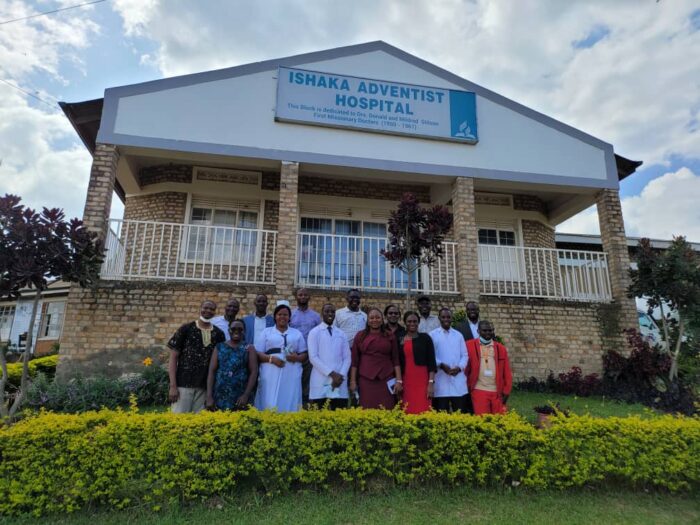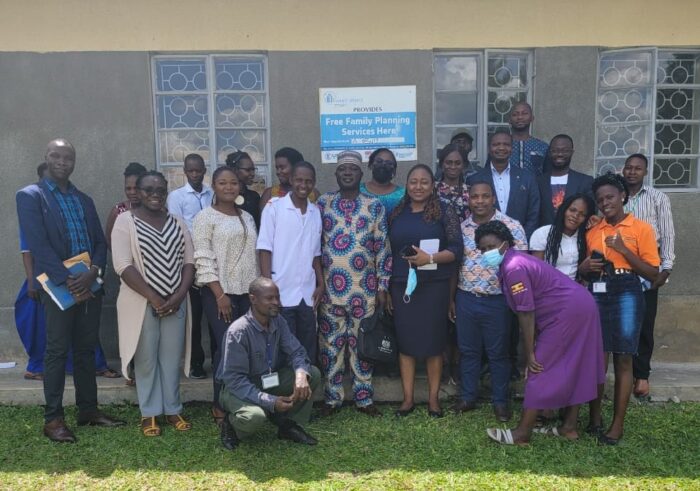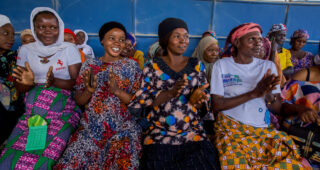“Every Number Is a Human Being”
“Children have always been left behind, both in Nigeria and globally,” says Nguavese Torbunde, M.D., on a Zoom call from her office in Abuja, Nigeria. “It’s like the train moves 20 kilometers and then you realize that you left your child behind, and you have to go back.”
“You need to make a difference here”
Dr. Torbunde manages the Elizabeth Glaser Pediatric AIDS Foundation’s (EGPAF’s) innovative pediatric and adolescent HIV programs in 12 states across Nigeria, in addition to leading the technical strategy for EGPAF’s presence in the country. She talks about her work with passion, but she hasn’t always been focused on HIV. When Dr. Torbunde was in medical school at University of Jos, Plateau State, Nigeria, she wanted to be a clinical pediatrician.
“I had no desire for public health or HIV medicine, but when I started working in my hometown after graduation, I was shocked at the number of people living with HIV in the country,” Dr. Torbunde says. “Due to the intense stigma around HIV, people would never disclose their HIV status. It was not until I went back and started working in the clinic in my hometown that I learned members of my community were living with HIV. I would never have known unless I was working at the clinic where people seek care.”

When Dr. Torbunde started working as a medical doctor there were few HIV treatment regimens available, and many of them came with a laundry list of challenges, ranging from side effects and frequent medicine stock-outs to inadequate training resources. Clinicians did not have the tools they needed to provide quality care.
“So many people were living with HIV, but many were dying,” Torbunde says. “It was scary, it was sad, and I knew something had to be done. I said to myself, You need to be in this space—you need to make a difference here.”
Since Dr. Torbunde graduated medical school 13 years ago, she has spent 10 of them working on HIV implementation. In that time, Nigeria has made steady progress towards achieving epidemic control. According to UNAIDS, 90% of people living with HIV in Nigeria know their status, and 86% of people living with HIV in Nigeria are on effective antiretroviral treatment (ART). However, the picture remains bleak for children, even in Nigeria.
The gap: Children are still being left behind
“We’ve only been able to identify and enroll 45% of children living with HIV in Nigeria while adult coverage is 86%,” Dr. Torbunde says.
This is not just a Nigeria issue. Internationally, only 54% of children living with HIV are on treatment.

“There are really strong programs in Nigeria already that are making great headway in fighting HIV in adults,” says Dr. Torbunde, “but children have remained a challenge. That is why EGPAF has been very strategic in what we are doing—our strategy is to hone innovations to close the gaps that the other existing programs are struggling with, specifically in pediatric HIV case identification and improving treatment outcomes.”
“EGPAF has implemented pediatric and adolescent services in many countries,” says Judith Kose, M.D., EGPAF’s global director of pediatric and adolescent services, based in Nairobi, Kenya. “The EGPAF technical team has developed really strong and innovative packages based on that experience, and we want to support the roll-out of relevant innovative tools that we have seen make a difference in the communities we serve.”
Innovations in finding and treating children living with HIV
Two innovative projects have given Dr. Torbunde the resources she needs to leverage EGPAF’s decades of experience and expertise in addressing pediatric HIV. Through the Breakthrough Project, funded by ViiV Healthcare Positive Action, EGPAF supports innovations to improve case identification and retention in care among children and adolescents. This involves, among other things, placing trained pediatric case managers in health facilities to steer pediatric HIV services.
“Ninety percent of children living with HIV are in families, so if we identify one person, we look at them as a member of a family and we follow that person to see if there might be related children at risk of HIV,” Dr. Torbunde explains. This intervention has helped sites focus testing resources on the people most likely in need of care and treatment.
Through the New Horizons project, funded by Johnson and Johnson (J&J), EGPAF-Nigeria is investigating drug resistance patterns for children on first- and second-line regimens and working to improve access to the highest quality treatments for children, adolescents, and young adults. In another J&J grant, EGPAF is working with selected clinics in two states to improve and scale up early-infant diagnosis, which can both improve case identification and help catch HIV early, reducing the chances that a child develops potentially life-threatening advanced HIV disease.
South-to-South knowledge-sharing
One of the major strengths of these programs is that they span multiple countries.
“If there is a challenge we are facing here in Nigeria, there is a strong chance that project staff have faced, and maybe resolved, this challenge in another setting,” Dr. Torbunde says. “We have an opportunity to learn from our colleagues in neighboring countries.”

For example, one of the challenges the Nigeria team faces is poor treatment outcomes for children.
“The pediatric HIV program started in 2006 in Nigeria,” says Dr. Appolo Tiam, M.D., vice president of Technical Strategy and Innovation at EGPAF. “This means that those children initiated on treatment when the program first started have now been on treatment for 16 years. The quality of pediatric care and treatment available at the time was inconsistent, and many of the children developed resistance and are on third-line regimens. Children are still really struggling.”
EGPAF-Uganda, on the other hand, has made remarkable strides in pediatric treatment outcomes, and Dr. Torbunde sees an opportunity to learn from her peers.
“We recently traveled to Uganda to speak to the Ministry of Health and to go to the facilities to find out what they are they doing differently, and to see if can we adapt some of their strategies to our local context,” says Dr. Torbunde.
Investing in strong and sustainable local health systems
“One thing we do, unique to EGPAF, is that we engage a lot in building the government’s capacity to run high-quality programs themselves,” Dr. Torbunde says. “This is to ensure that the government has the ability to take ownership of the program so that even when donor funds end in the country, the program can be sustained.”
Building capacity can mean many things, but for Dr. Torbunde, it means connecting experts in pediatric HIV from various states for collaboration, providing training for healthcare staff on updated national guidelines, leveraging network with other experts across sub-Saharan Africa to share innovations for improving quality of care, and supporting clinics in implementing strong interventions.

Forming brain trusts: Technical working groups identify and solve problems
In Nigeria, national and state technical working groups pull key stakeholders together around one topic, such as HIV or TB.
“The role of these technical working groups is to bring together all key players. Together they look at the program data and communications in the HIV space, identify challenges, and work on those challenges as a team,” Dr. Torbunde says.
“For example, maybe a site is struggling with treatment failure and they are lost on what to do. So now in this technical working group we have a pediatrician going in front of the policymaker and explaining what challenges are there, so they know what needs funding and what needs to be scaled up.”
While these have proved tremendously successful nationally, these groups at the state level were struggling. In the states that EGPAF supports, Dr. Torbunde and her team have been helping these groups get off the ground. “We’ve helped groups think through their role in the state’s HIV response, redesigned the structure of their meetings, identify who should be part of the group, and what support is needed. One of the difficulties was that often challenges that were identified and had no follow up. What we do is support these technical working groups to follow up and make sure that solutions are implemented and gaps identified are closed.”
Stepping up training, mentorship, and coaching
EGPAF-Nigeria staff also provide mentorship and coaching to staff across the healthcare system, from community health workers to nurses, doctors, and beyond.
“Guidelines change all the time, and EGPAF is very agile,” Dr. Torbunde says. “Dr. Tiam recently visited and gave a presentation to local pediatricians from health facilities that manage third-line clients on new World Health Organization guidelines, as well as innovative strategies from other sub-Saharan contexts, and peoples’ eyes were opened. Even for clinicians and researchers that work with children every day, there was something new for everyone to learn.”
“There was something new for everyone to learn”
‘”I am so excited that my patients who are virally unsuppressed would soon have aid to pave way for better management,” said Adewunmi Oyesakin, M.D., consulting pediatrician, National Hospital Abuja, who attended an EPGAF workshop on third line treatment. “I have been stimulated research-wise. Every facilitator at the workshop was quite lively and displayed knowledge with good time management. The technical support was excellent.’’

In addition to updated guidelines, Torbunde and global EGPAF experts are able to offer existing health facility staff at government-run hospitals training on EGPAF’s evidence-based toolkits, such as those on disclosure (developed in collaboration with young people living with HIV in sub-Saharan Africa), management of treatment failure, and transition of adolescent and youth care to optimal treatment regimens. We also work with site staff and the technical working groups to bring them forward to the Ministry of Health for wider adoption.
“We also work with site level staff to understand their data and what is happening at their site,” Dr. Torbunde says. “This has had beautiful impacts because it helps site staff understand what gaps they face, why those gaps exist, and then we can work with them and the technical working group to find and implement a solution.”
Finding those who are left behind
“Beyond all, I see Nigeria being able to achieve epidemic control,” says Dr. Torbunde. “In the adult population, it’s really looking that way already, but in the pediatric population we need to put in more effort, especially on mother-to-child transmission. We have 21,000 new pediatric infections every year due to gaps in the prevention of mother-to-child HIV transmission program. I see EGPAF collaborating with other partners to eliminate these gaps in the next five years.”
“Every number is a human being,” says Dr. Torbunde. “Here in Nigeria, we have 130,000 children living with HIV and only 59,000 on ARVs. My colleagues and I are focused not just on numbers-based targets, but on the individual beyond the number, on a case-by-case basis, finding those who are being left behind.”
Eric Bond and Sarah Denison-Johnston
Nigeria
Pediatric HIV Diagnosis, Care & Treatment; Strengthening Local Capacity



